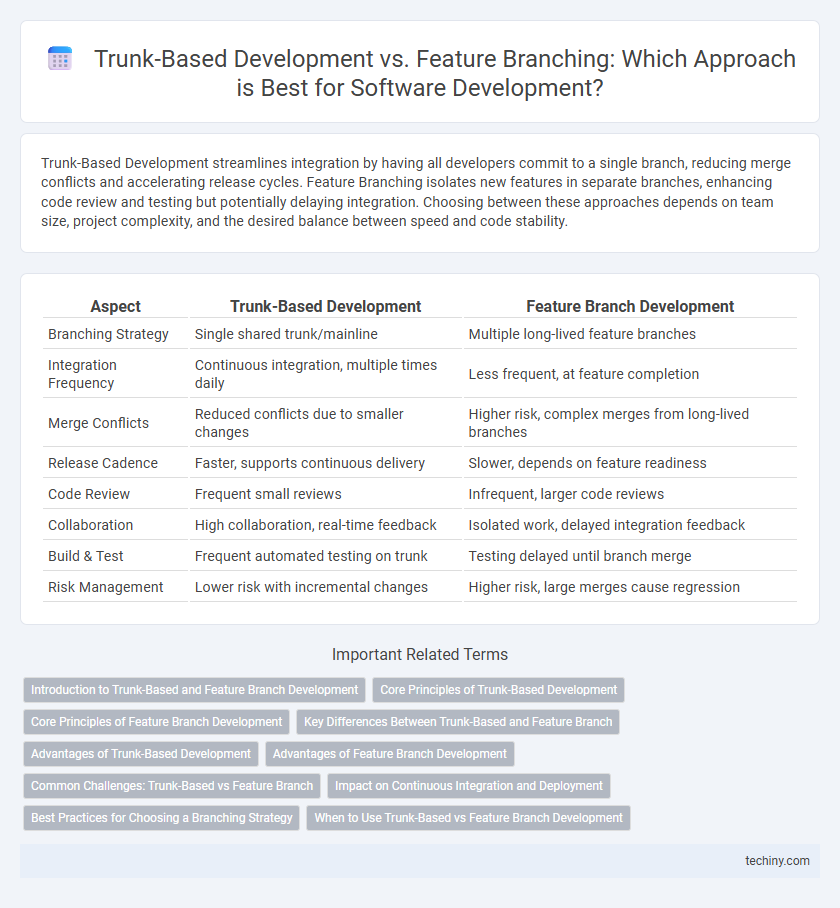Trunk-Based Development streamlines integration by having all developers commit to a single branch, reducing merge conflicts and accelerating release cycles. Feature Branching isolates new features in separate branches, enhancing code review and testing but potentially delaying integration. Choosing between these approaches depends on team size, project complexity, and the desired balance between speed and code stability.
Table of Comparison
| Aspect | Trunk-Based Development | Feature Branch Development |
|---|---|---|
| Branching Strategy | Single shared trunk/mainline | Multiple long-lived feature branches |
| Integration Frequency | Continuous integration, multiple times daily | Less frequent, at feature completion |
| Merge Conflicts | Reduced conflicts due to smaller changes | Higher risk, complex merges from long-lived branches |
| Release Cadence | Faster, supports continuous delivery | Slower, depends on feature readiness |
| Code Review | Frequent small reviews | Infrequent, larger code reviews |
| Collaboration | High collaboration, real-time feedback | Isolated work, delayed integration feedback |
| Build & Test | Frequent automated testing on trunk | Testing delayed until branch merge |
| Risk Management | Lower risk with incremental changes | Higher risk, large merges cause regression |
Introduction to Trunk-Based and Feature Branch Development
Trunk-Based Development centralizes code integration by encouraging developers to commit directly to a single shared branch, promoting faster feedback and reducing merge conflicts. Feature Branch Development isolates work into separate branches tied to specific features, enabling parallel development and focused testing before merging into the main branch. Both strategies impact release frequency, code quality, and collaboration dynamics within DevOps workflows.
Core Principles of Trunk-Based Development
Trunk-Based Development emphasizes continuous integration with all developers committing regularly to a single shared branch, ensuring immediate feedback and preventing long-lived feature divergence. This approach enhances collaboration, reduces merge conflicts, and fosters rapid delivery by minimizing integration complexities. Core principles include small, frequent commits, feature toggles for incomplete work, and strict branch lifespan limits to maintain a stable and releasable mainline.
Core Principles of Feature Branch Development
Feature branch development centers on isolating new features in distinct branches, enabling concurrent work without disrupting the main codebase. Core principles emphasize continuous integration by regularly merging feature branches back into the main branch to detect conflicts early and maintain code stability. This approach fosters focused development, thorough code reviews, and controlled feature rollouts, enhancing collaboration and quality assurance.
Key Differences Between Trunk-Based and Feature Branch
Trunk-Based Development emphasizes continuous integration by having developers commit small, frequent changes directly to a single shared branch, reducing merge conflicts and improving code quality. Feature Branch Development isolates work in separate branches for each feature, allowing parallel development but often leading to longer integration cycles and potential merge complexities. The key differences lie in integration frequency, branch strategy, and workflow agility, with Trunk-Based enabling faster feedback loops and Feature Branch supporting isolated, reviewable changes.
Advantages of Trunk-Based Development
Trunk-Based Development enhances continuous integration by allowing developers to commit small, frequent changes directly to the main codebase, reducing integration conflicts and speeding up delivery cycles. This approach improves collaboration and code quality through rapid feedback loops and simplified version control management, supporting agile and DevOps practices effectively. Teams practicing Trunk-Based Development often experience faster releases, higher deployment frequency, and reduced merge complexity compared to feature branch workflows.
Advantages of Feature Branch Development
Feature branch development enhances code stability by isolating new features or bug fixes, reducing the risk of disrupting the main codebase. It allows parallel development, enabling multiple teams to work on different features simultaneously without conflicts. Comprehensive code review and testing become more manageable, improving overall software quality and maintainability.
Common Challenges: Trunk-Based vs Feature Branch
Trunk-based development often faces challenges like managing integration conflicts due to frequent commits to the main branch, which can complicate continuous integration pipelines. Feature branch workflows risk prolonged integration periods, leading to merge conflicts and delayed feedback loops that impact deployment velocity. Both approaches require robust version control strategies and automated testing frameworks to mitigate risks associated with code divergence and integration bottlenecks.
Impact on Continuous Integration and Deployment
Trunk-Based Development promotes faster integration by merging small, frequent changes directly into the main branch, reducing integration conflicts and enabling smoother continuous integration (CI) pipelines. Feature Branching can delay integration until feature completion, causing larger merge conflicts and potentially slowing continuous deployment (CD) cycles. Adopting Trunk-Based workflows enhances deployment frequency and reliability, essential for agile DevOps environments focused on rapid delivery and minimal downtime.
Best Practices for Choosing a Branching Strategy
Selecting an effective branching strategy in software development hinges on team size, release frequency, and collaboration needs. Trunk-based development fosters continuous integration with rapid feedback cycles, ideal for small to medium teams delivering frequent updates. Feature branching enables isolated development and parallel workstreams, suitable for larger teams requiring rigorous code reviews and controlled releases.
When to Use Trunk-Based vs Feature Branch Development
Trunk-based development is ideal for teams aiming for continuous integration and rapid deployment, reducing merge conflicts and promoting frequent code integration. Feature branch development suits projects requiring isolated, extensive feature work or strict code review processes, ensuring high stability before integration. Selecting between them depends on release frequency, team size, and the complexity of the features being developed.
Trunk-Based vs Feature Branch Infographic

 techiny.com
techiny.com